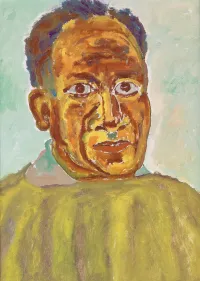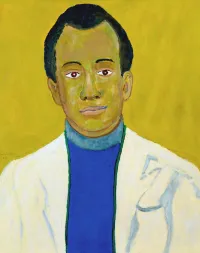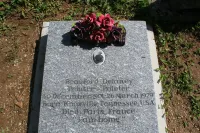Biography
1901 - 1979
"The abstraction, ostensibly, is simply for me the penetration of something that is more profound in many ways than rigidity of a form. A form if it breathes some, if it has some enigma to it, it is also the enigma that is the abstract, I would think."
- Beauford Delaney
A naturally gifted artist, Delaney painted his first commission at the age of 14. He moved to New York City at the dawn of the Great Depression, where poignant victims of that bleak era were immortalized in many of his greatest paintings. A sensitive and deeply introverted person, he became part of a gay bohemian circle of mainly white colleagues in Greenwich Village. But when he traveled to Harlem to visit his African-American friends he feared they would be repelled by his gay identity. Alone at the age of 52, with no romantic friendships in his life, Delaney left New York for Paris in 1953. The move led to a dramatic stylistic shift from the figurative compositions of New York life to abstract expressionist studies of color and light. Delaney's provocative and innovative work increasingly gained attention, but a life-time of heavy drinking had begun to impair his often fragile mental and physical health and he was soon no longer able to cope with daily life. James Baldwin, who had become one of his closest friends in Paris, was forced to commit Delaney to St. Anne's Hospital for the Insane in the spring of 1975. He died on March 29, 1979 from complications due to advanced alcoholism and Alzheimer’s. Looking back, in 1985, Baldwin said Delaney was "the first living proof, for me, that a black man could be an artist… [for] great art can only be created out of love, and no greater lover has ever held a brush." Today Delaney’s work can be found in the finest galleries in the world, including the Smithsonian Institute in Washington, DC.
1901 - 1979
"The abstraction, ostensibly, is simply for me the penetration of something that is more profound in many ways than rigidity of a form. A form if it breathes some, if it has some enigma to it, it is also the enigma that is the abstract, I would think."
- Beauford Delaney
A naturally gifted artist, Delaney painted his first commission at the age of 14. He moved to New York City at the dawn of the Great Depression, where poignant victims of that bleak era were immortalized in many of his greatest paintings. A sensitive and deeply introverted person, he became part of a gay bohemian circle of mainly white colleagues in Greenwich Village. But when he traveled to Harlem to visit his African-American friends he feared they would be repelled by his gay identity. Alone at the age of 52, with no romantic friendships in his life, Delaney left New York for Paris in 1953. The move led to a dramatic stylistic shift from the figurative compositions of New York life to abstract expressionist studies of color and light. Delaney's provocative and innovative work increasingly gained attention, but a life-time of heavy drinking had begun to impair his often fragile mental and physical health and he was soon no longer able to cope with daily life. James Baldwin, who had become one of his closest friends in Paris, was forced to commit Delaney to St. Anne's Hospital for the Insane in the spring of 1975. He died on March 29, 1979 from complications due to advanced alcoholism and Alzheimer’s. Looking back, in 1985, Baldwin said Delaney was "the first living proof, for me, that a black man could be an artist… [for] great art can only be created out of love, and no greater lover has ever held a brush." Today Delaney’s work can be found in the finest galleries in the world, including the Smithsonian Institute in Washington, DC.
Demography
Demography
Gender Male
Sexual Orientation Gay
Gender Identity Cisgender
Ethnicity African American Black
Nations Affiliated France United States
Era/Epoch Cold War (1945-1991) Great Depression (1929-1939) Harlem Renaissance (1919-1929)
Field(s) of Contribution
Art
Commemorations & Honors
Work Exhibited in the Philadelphia Museum of Art, Harvard University Art Museums, Art Institute of Chicago, Knoxville Museum of Art, The Minneapolis Institute of Arts, The Newark Museum, The Studio Museum in Harlem, and the Smithsonian American Art Museum
Demography
Gender Male
Sexual Orientation Gay
Gender Identity Cisgender
Ethnicity African American Black
Nations Affiliated France United States
Era/Epoch Cold War (1945-1991) Great Depression (1929-1939) Harlem Renaissance (1919-1929)
Field(s) of Contribution
Art
Commemorations & Honors
Work Exhibited in the Philadelphia Museum of Art, Harvard University Art Museums, Art Institute of Chicago, Knoxville Museum of Art, The Minneapolis Institute of Arts, The Newark Museum, The Studio Museum in Harlem, and the Smithsonian American Art Museum
Resources
Resources
Capozzola, Christopher. "Beauford Delaney and the Art of Exile." The Gay and Lesbian Review 10.5 (September-October 2003): 10-12.
Leeming, David. Amazing Grace: A Life of Beauford Delaney. New York: Oxford University Press, 1998.
http://www.outhistory.org/exhibits/show/aa-history-month-bios/beauford-delaney
https://www.nytimes.com/2016/09/08/arts/international/beauford-delaney-returns-to-the-scene.html
http://americanart.si.edu/collections/search/artist/?id=1186
Resources
Capozzola, Christopher. "Beauford Delaney and the Art of Exile." The Gay and Lesbian Review 10.5 (September-October 2003): 10-12.
Leeming, David. Amazing Grace: A Life of Beauford Delaney. New York: Oxford University Press, 1998.
http://www.outhistory.org/exhibits/show/aa-history-month-bios/beauford-delaney
https://www.nytimes.com/2016/09/08/arts/international/beauford-delaney-returns-to-the-scene.html
http://americanart.si.edu/collections/search/artist/?id=1186









